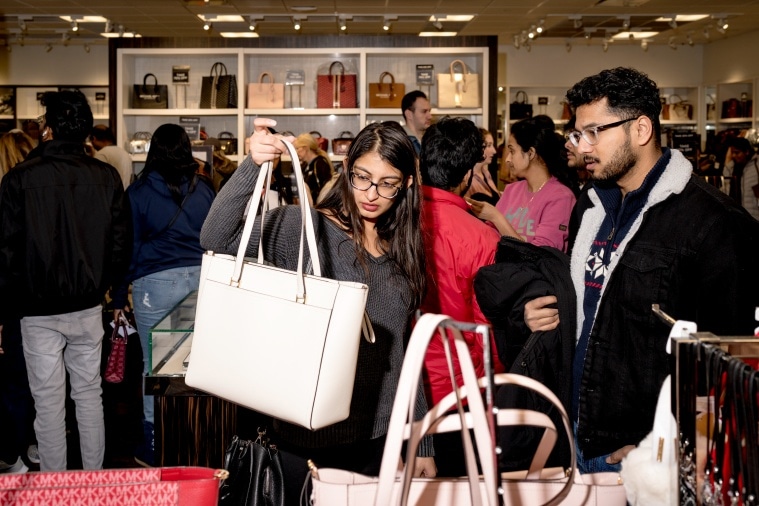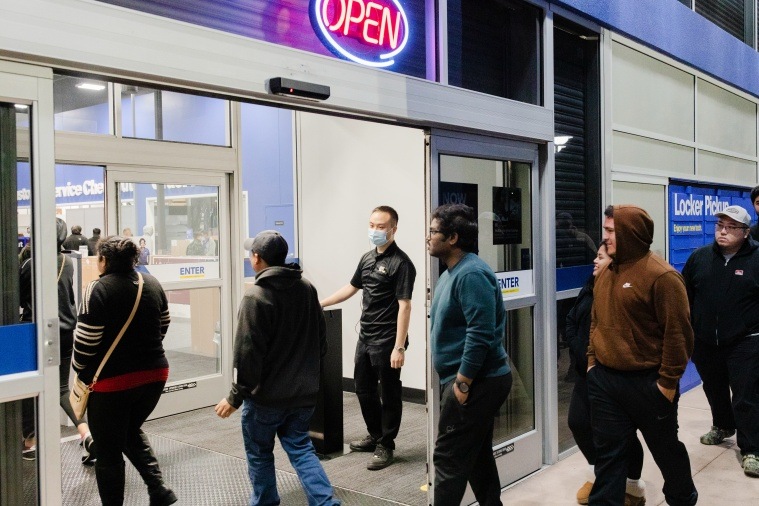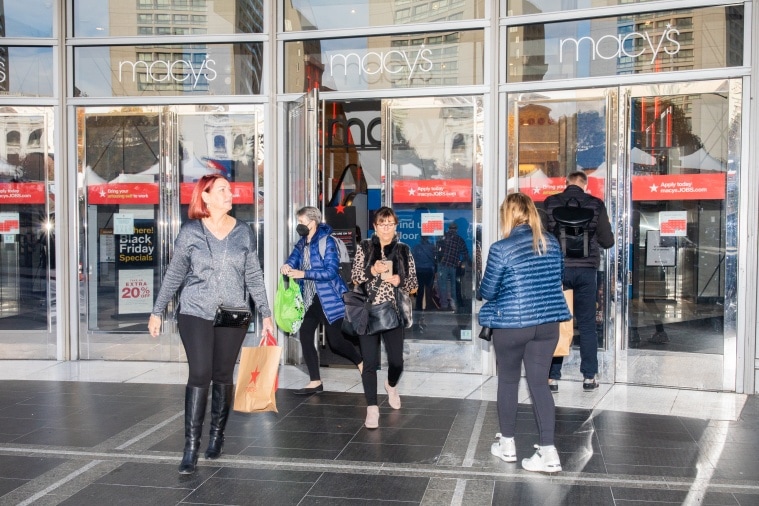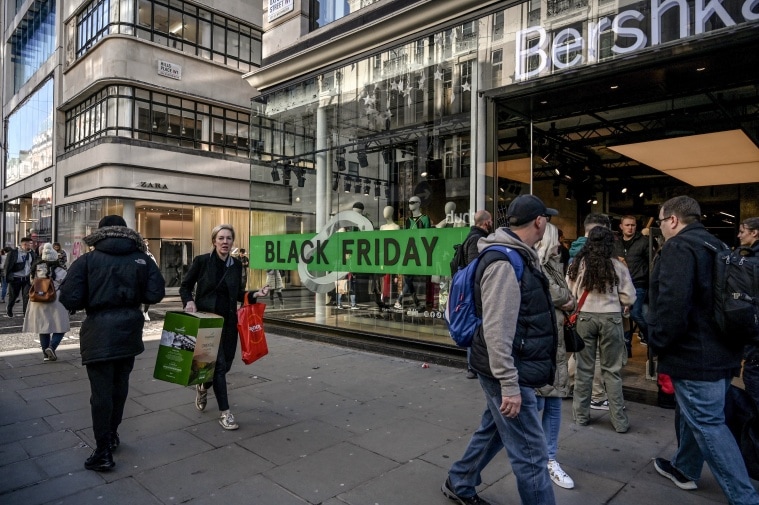Stay updated with the latest - Click here to follow us on Instagram
Retailers push sales, and normalcy, but US economic uncertainty looms
Shoppers who ventured out Friday, and even those who didn’t, saw a deluge of deals that had been missing the past couple of years. Still, near-record inflation and dwindling savings kept some shoppers home and left retailers unsure what the season would ultimately bring.
 Shoppers at the El Remate Discount store on Black Friday in El Paso, Texas on Nov. 25, 2022. The holiday shopping season is the most important time in the retail industry, a period when many companies make a significant amount of their money for the year. (Justin Hamel/The New York Times)
Shoppers at the El Remate Discount store on Black Friday in El Paso, Texas on Nov. 25, 2022. The holiday shopping season is the most important time in the retail industry, a period when many companies make a significant amount of their money for the year. (Justin Hamel/The New York Times)Written by Jordyn Holman
After two years of pandemic improvisation and in-store restrictions, this year’s Black Friday felt like a return to normalcy.
Shoppers who ventured out Friday, and even those who didn’t, saw a deluge of deals that had been missing the past couple of years. Many retailers pushed lower prices in stores and online in response to Americans having recently shown that they were more than willing to wait for a discount before making a purchase.
 Shoppers crowd around the doors at El Remate Discount, waiting for the store to open, on Black Friday in El Paso, Texas on Nov. 25, 2022. (Justin Hamel/The New York Times)
Shoppers crowd around the doors at El Remate Discount, waiting for the store to open, on Black Friday in El Paso, Texas on Nov. 25, 2022. (Justin Hamel/The New York Times)
“I think we’re going back to what we had before the pandemic with what we’re offering on Black Friday,” said Stephen Lebovitz, the CEO of CBL Properties, which owns about 95 properties, including shopping centres and malls across the United States. “There are changes, but it’s going to feel a lot more like 2019 Black Friday than anything in the interim years.”
Still, near-record inflation and dwindling savings kept some shoppers home and left retailers unsure what the season would ultimately bring.
Many well-off consumers remain stable financially and appear ready to spend, but others face far more economic uncertainty. That isn’t expected to change anytime soon. Analysts, economists and retail executives are monitoring a potential economic slowdown in the first few months of 2023 that could worsen consumers’ wariness.
 Shoppers at the Michael Kors Outlet at Great Lakes Crossing mall on Black Friday in Auburn Hills, Mich. on Nov. 25, 2022. (Nic Antaya/The New York Times)
Shoppers at the Michael Kors Outlet at Great Lakes Crossing mall on Black Friday in Auburn Hills, Mich. on Nov. 25, 2022. (Nic Antaya/The New York Times)
That makes the holiday season — always the most important time for retailers — even more crucial this year.
As the day began at Macy’s Herald Square, the department store’s flagship location in New York, there was a steady flow of customers, and store employees clapped as people entered. Some said they were excited to shop but had concerns over prices.
Tammy Freeman, 59, from New York, stood at the front of the line near the store’s main entrance, ready for her annual Black Friday excursion. She said that she was eager to buy various items, including a case for her daughter’s laptop, but noted that inflation was changing her general approach to spending.
 Shoppers walk past department stores advertising Black Friday deals on Regent Street, in the Oxford Circus district of London on Nov. 25, 2022. U.S.-style Black Friday sales have become common in Europe, as the holiday shopping season shifts earlier, but with less disposable income, buyers may be more wary this year. (Mary Turner/The New York Times)
Shoppers walk past department stores advertising Black Friday deals on Regent Street, in the Oxford Circus district of London on Nov. 25, 2022. U.S.-style Black Friday sales have become common in Europe, as the holiday shopping season shifts earlier, but with less disposable income, buyers may be more wary this year. (Mary Turner/The New York Times)
“I have to budget more,” she said. “I have to catch the sales more.”
Eighty percent of holiday shoppers are likely to make a purchase from Black Friday through Cyber Monday, according to a survey from Bankrate. People shopping online pulled out their wallets on Thanksgiving Day as well, with sales up 2.9% compared with a year earlier, according to Adobe Analytics, which tracks online sales. Adobe estimated that online spending for the holiday season would increase 2.5% from last year. It said it had calculated that online prices were down 0.7% in October compared with last year, largely because of early holiday deals, although they rose 0.3% from September.
On Friday, bargain-hunting shoppers definitely seemed to have the power. Stores posted signs advertising 50% to 60% off items. At a Target in Springfield, Illinois, shoppers walked around with 65-inch televisions in shopping carts, and some wore matching T-shirts that said, “Gather, gobble and shop.”
 Shoppers enter a Best Buy in Union City, Calif. on Black Friday, Nov. 25, 2022. (Alex Welsh/The New York Times)
Shoppers enter a Best Buy in Union City, Calif. on Black Friday, Nov. 25, 2022. (Alex Welsh/The New York Times)
In San Francisco’s Union Square, it was relatively quiet. By 7 a.m., when the line outside Macy’s had dissipated, it felt “more or less like a normal day,” said Clifford Cheng, a retail associate at the store.
At a nearby Neiman Marcus, only about a dozen shoppers waited outside before the store’s 9 a.m. opening. Natali Carrasco, 20, and Batechaa Steele, 20, were first-time Black Friday shoppers at the luxury department store.
“We always come and shop here, but we always buy full price, so we wanted to see the sales,” Carrasco said.
 Shoppers on Black Friday in San Francisco on Nov. 25, 2022. (Alex Welsh/The New York Times)
Shoppers on Black Friday in San Francisco on Nov. 25, 2022. (Alex Welsh/The New York Times)
Even before the start of the season, some shoppers were already cutting back on discretionary purchases, leaving retailers with an unusually high level of inventory. They want to unload as much of that as possible before the start of the new year.
“The more sales merchandise that they move through now, the better,” said Kristen Gall, president of the online platform Rakuten, which offers cash-back deals. “Because if you get caught holding a lot of inventory in January and February and consumers pull back because things feel significantly more recessionary, that’s where the worry comes in for retailers.”
Despite the economic unease shoppers have expressed, retailers said they were optimistic.
“Even in really tough years, Black Friday is a very strong day for us,” Jeff Gennette, Macy’s CEO, said in an interview.
And there were promising signs. Forty percent of consumers said they planned to shop in malls this holiday season, higher than the 35% of consumers who did during the 2019 Christmas season, before pandemic lockdowns, according to a survey from consultancy KPMG. Last year, the number of shoppers who said they planned to venture inside a mall was 31%.
 Shoppers walk past a department store advertising Black Friday deals in the Oxford Circus district of London on Nov. 25, 2022. (Mary Turner/The New York Times)
Shoppers walk past a department store advertising Black Friday deals in the Oxford Circus district of London on Nov. 25, 2022. (Mary Turner/The New York Times)
Americans were also still purchasing gifts online. Adobe said online sales for Black Friday were expected to total $9 billion, up 1% year-over-year.
Retailers took different approaches to entice shoppers to spend. Macy’s did not bring back the opening doorbuster deals — which went away during the pandemic amid social distancing guidelines — and instead offered sales throughout the day. It also continued the pandemic-era tradition of having Santa take photos with children while seated behind a desk, a sign that COVID-19 concerns remain.
J.C. Penney leaned back into doorbusters for the first time since 2019 because it said it wanted to motivate discount-focused shoppers to get out to stores. For its 5 a.m. doorbusters, the department store chain deliberately kept “pre-inflation pricing” on key items like Instant Pots, bath towels and boots. Signs in stores trumpeted 65% off discounts.
“We think we’ll have a big volume of customers at the store, and to bring them in we know that value is very important to the consumer right now,” said Marc Rosen, J.C. Penney’s CEO.
On its website, mall owner CBL highlighted the discounts that stores like H&M and children’s apparel retailer Carter’s were offering. Other retailers employed a similar strategy in the days leading up to Black Friday. J. Crew on Monday advertised 50% off purchases. On Gap’s website, a large black banner scrolled atop the page saying “HPY BLK FRI” and highlighting 50% off deals with an additional 10% markdown.
There are risks for retailers, however, in relying more heavily on deals. The practice erodes profit margins that buoyed them during the pandemic, when many Americans spent plenty on all sorts of goods and retailers did not feel the need to entice them with too many deals. There are also worries that shoppers will become so accustomed to sales that they will only buy when promised a lower price.
“Consumers understanding that they can wait out discounts, coupled with retailers’ drive to move goods, likely means that this Black Friday will be more important than Black Friday has been in a long time,” said Simeon Siegel, a managing director at BMO Capital Markets. “Whether that’s good for the brands, whether that’s good for the consumer — that’s a separate conversation.”
Retailers are also competing more with entertainment options, like concerts and dining out at restaurants, than they have in the past couple of years. Consumers are expected to allocate a larger share of their holiday spending on experiences this year compared with last. The average amount that middle-income Americans, who make $50,000 to $99,000 annually, spend on experiences is expected to increase 15% this year, according to a survey released in October from Deloitte.
Of course, not every retailer places so much importance on Black Friday.
Outdoor equipment retailer REI has remained closed on the day since 2015. This year, the company said it had decided to permanently give its workers a paid day off on Black Friday, encouraging them to spend time outside instead.
But that was the exception. Even while the total sales for Black Friday were still being tallied, many retailers were already looking to further entice shoppers by rolling out advertisements for more discounts Monday.
“We believe that the consumer is quite aware of the fact that there’s plenty of inventory out there,” Richard Hayne, the CEO of Urban Outfitters, said on a call with analysts this month. “And what they’re doing is waiting for big promotional events that normally occur on Black Friday and Cyber Monday in order to make their purchases.”
Retailers may need to offer more deals, he said, but “I don’t believe it will be a total bloodbath.”



- 01
- 02
- 03
- 04
- 05




























